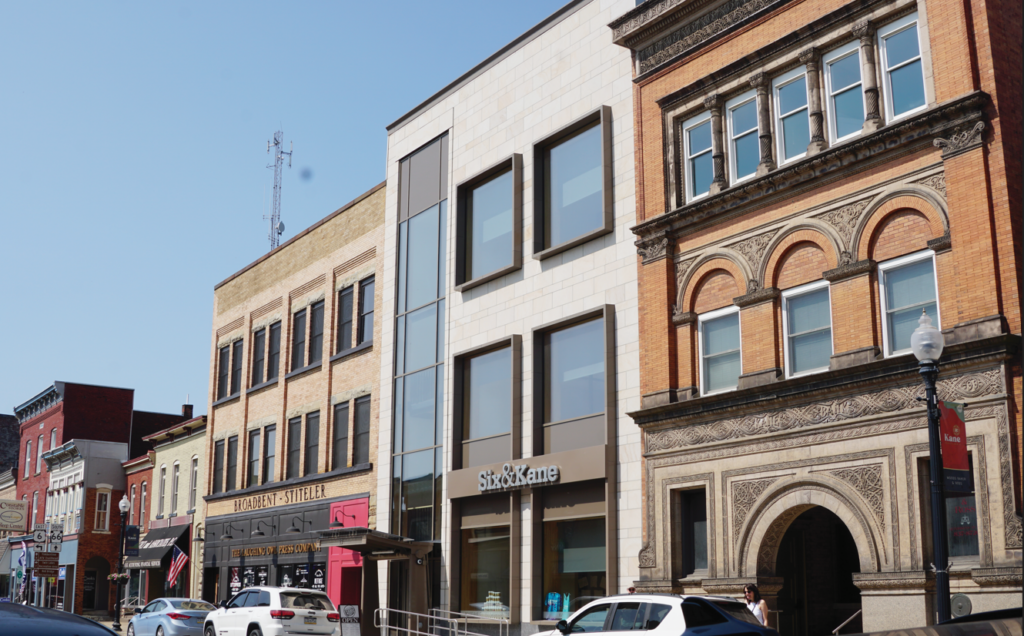Six&Kane

Project Name:
Six&Kane
Project Square Footage (ft2):
10,000
Year Built:
2022
Green Building Certifications:
EnerPHit Plus
Project Team:
Moshier Studio, Envinity, Inscale Architects, Michael L. Norris Associates, J.A. Luciano & Sons, Brace Engineering, Steger Masonry, Dinsmore Welding and Fabricating, Marcon Roofing, Allied Systems, Peak Building Products
Please provide a brief description of the project.
In 2019, West Penn Energy Fund purchased a vacant commercial building in Kane, Pa., a rural community at the gateway to the Allegheny National Forest, and transformed it into a beautiful, high-performance building that is a model of adaptive reuse.
Renovated and reborn as the first Passive House EnerPHit Plus office building in North America, Six&Kane produces on-site electricity, was built with high-performance building materials, and features abundant fresh air and daylight. The project also incorporated workforce training to equip builders and contractors with Passive House design skills.
Six&Kane was envisioned, planned, and built to create lasting economic, environmental, and educational impact, and the project continues to influence regional growth, including development of the Kane Area Children’s Museum and the Johnsonburg Community Trust Brick Block.
GBA honored the Six&Kane project with a Vanguard Award in 2025. View the video of the award.
How did the building’s team work together to address sustainability and building performance?
Moshier Studio worked closely with Envinity, the Construction Manager, during the design and construction phases of the project. Together with the sub consultants, sub contractors and material suppliers, the airtightness, insulation and building services systems were tightly integrated and carefully executed.
What were the major challenges in the project related to building performance, and how did the project team work to overcome them?
The five principles of Passive House – airtightness, insulation, high performance windows, thermal bridge free design and energy recovery ventilation – are challenging to deliver in new construction, and delivering these in a renovation was a challenge. An additional challenge was the pandemic and the ensuing supply chain issues. The entire team rallied around the challenges, the Construction Manager did a superb job of explaining the why and how of maintaining airtightness and thermal breaks.
What are the project’s key sustainability features?
A major focus of the design and construction was airtightness. A fluid-applied vapor-permeable air barrier was applied to the party and rear walls after the inside surfaces were cleaned and pointed. The OSB sheathing on the roof and east wall have a factory-applied vapor-permeable air barrier attached, which was sealed with acrylic tape and flashing. The same sheathing product was used over the existing wood subfloor on the ground floor to separate the unconditioned basement from the conditioned upper floors.
The insulation scheme was to apply 200 mm of continuous insulation to the outside of the air barriers on the new construction and to the outside of the air-sealed and weather-sealed existing masonry. All wall insulation is graphite polystyrene (GPS) board, and the roof insulation is polyisocyanurate board. The ground floor over the basement has 300 mm of dense-pack blown-in fiberglass in the joist spaces, with 100 mm of GPS continuous below. Interior mineral fibre insulation was added at transition zones where the party walls intersected with exterior walls and inside the structural steel frame to mitigate conditions where the frame contacted the ground, and locations where the continuous insulation needed to be reduced due to adjacent construction.
The windows are a combination of fixed and operable UPVC windows and timber-framed curtainwall. All are triple-glazed with various low-e coatings tuned to the orientation. The east façade is clad with 50mm thick regionally sourced sandstone panels, and the rear façades are clad with ribbed steel siding. Both cladding systems are attached with thermally broken clip systems. The steel frame also allowed larger windows, admitting daylight and winter solar gain.
The mechanical system consists of a single Energy Recovery Ventilator serving the entire building. Heating and cooling is supplied by a Variable Refrigerant Flow heat pump with ducted and un-ducted air handlers throughout the building. Domestic Hot Water for the toilet rooms and office kitchenettes is tempered by small point-of-use demand heaters. The smoothie bar is served by a heat pump water heater that uses the heat rejected by the reach-in refrigerators and freezer in the bar’s storage room.
LED lighting is used throughout the building, and all appliances are Energy Star rated. One hundred and two 435-Watt PV panels on the roof, plus three 305-Watt panels on the front canopy supply 47,547 kWh/yr. of on-site renewable energy.
Results
Beyond the performance results summarized below, the project successfully exposed the community to the concepts of Passive House and created interest in and familiarity with the standard. The community embraced and supported the project enthusiastically during and after the construction period. Several dozen local tradespeople were trained in the craft of creating and maintaining an air barrier and thermally broken envelope throughout construction. During the project, the construction manager, who previously had his CPHT credential, also earned his CPHC, the local associated architect earned her CPHD, and the general contractor earned his CPHT credential. The project was designed and constructed during the COVID-19 pandemic, resulting in changes to material selections and delays due to supply chain and cost issues.
- Treated Floor Area 9838 ft²
- Space Heating Demand 4.41 kBTU/(ft²yr).
- Space Cooling Demand 1.91 kBTU/(ft²yr).
- Total Primary Energy Demand (Source EUI) 31.82 kBTU/(ft²yr).
- Total PER 15.02 kBTU/(ft²yr).
- Airtightness 0.23 ACH50.
What are your main takeaways or lessons learned from this project? Have these lessons informed other projects?
- “Own the envelope!” – Craig Stevenson
- Model early. Model often.
- Constantly look for and manage thermal bridges
- Build a culture of hypervigilance for air barrier and thermal breaks through the entire project team
- Avoid metal inside the envelope assembly, especially penetrating the insulation
- If you must use metal, bury it under continuous insulation, stainless steel, carbon steel, aluminum
- Advocate strongly for ongoing monitoring
What was the intended or actual impact of the project on its users or the surrounding community?
- Major investment in downtown Kane
- Renovated a blighted building
- Affirmed the value of the town
- Provides access to the neighboring building’s upper floors
- Community engagement
- A source of civic pride
- Multiple tours and events during design and construction
- Spurred the formation of a Building Science Based STEM Children’s Museum
- Local Materials: Hardwood, Sandstone Cladding, Metal Siding
- Exposed local trades to Passive House Practices
- Formal Passive House Training
- Associated Architect achieved CPHD
- General Contractor achieved CPHT
